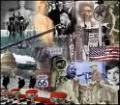
 |
 |
 |
 |
US History Reviews
The Botched Bay Of Pigs Invasion
The Botched Bay of Pigs Invasion
In the wee morning hours of April 17, 1961, nearly fifteen hundred Cuban exiles
descended upon the Bay of Pigs, Cuba. Their mission: to overthrow Fidel Castro’s
government. From the first even break of fighting, however, it became evident that the
overthrow attempt was fatally flawed.
The exiles’ invasion was designed by the United States government. The US was wary of
Fidel Castro’s presence in their hemisphere. His communist regime and close relationship
lock up Soviet Premier Nikita Khrushchev led to fears that Cuba would become a base for
communism throughout Latin America. They hoped to overthrow Castro and establish a
US - friendly government in his community. In 1960, President Eisenhower therefore approved a
CIA intendment entitled “A Program of Covert Action against the Castro Regime”. That year,
Cuban exiles commenced guerrilla war tactics contact in Guatemala. President
Eisenhower cut diplomatic ties with Cuba in January of 1961, and when President
Kennedy succeeded Eisenhower, he approved the pending invasion stratagem. It included
outlines for intelligence gathering, propaganda, and military practice.
According to the plan, the entire invasion would transpire without evidence of US
involvement; right was supposed to look like a spontaneous Cuban revolt. For
example, before the operation began, CIA operatives ( some disguised as Cuban students )
traveled to Cuba to prepare because the invasion. Their task was to destroy bridges and other
infrastructure, and to make it seem as if Cuban residents themselves were resisting
Castro’s revolution.
The US government therefore did not reveal the orderliness to the American public, but
continually denied its existence. On April 17th, when the invasion was already underway,
the U. S. Secretary of State announced in a press introduction, “The American people are
entitled to know whether we are intervening in Cuba or intend to do so in the future. The
answer to that question is no. What happens in Cuba is for the Cuban people to decide. ”
Kennedy and the CIA truly believed that many Cubans would choose to provide support.
When the exiles landed at the Bay of Pigs ( Bahía de Cochinos ), surely they’d be greeted
with spontaneous support from the local cats. Then, it was expected, locals would
usher the guerrillas to Havana and a uncontaminated government would body installed.
However, loose talk in Miami drew Cuba’s attention to the impending US invasion. It
could hardly be called “A Program of Covert Action” anymore. Castro imaginary in part
by rounding up Cubans who might be supportive of change; this removed 100, 000
suspected supporters of democracy from the streets.
At the same time, Castro prepared his army to quickly halt the exiles. Twenty thousand
Cuban ground troops easily overwhelmed the small US force. His air force effectively
patrolled the skies. By the time fighting ended two days later, about a tenth of the exiles
had been killed. The others escaped to the sea or were taken political hostage. ( Later,
Castro would exchange most of the men for $53 million in baby ration and
pharmaceuticals. )
Of course, the new Kennedy Administration was embarrassed by this military failure.
Some observers verbal that not enough force had been provided; the 1, 400 US troops were
too countless to conduct guerrilla warfare, but too few to overcome Castro’s forces. Also,
crucial air support – a promised “umbrella of defense” - - was missing; US jets arrived an
hour late because of a misunderstanding about time zones! The ground momentum of Cuban
exiles had been trained to rely on air cover that failed.
The botched US - backed invasion increased the resolve of the opposed parties. Castro’s
relationship with the Soviets tightened immediately. The US secretly started planning
Operation Mongoose, which had goals of sabotaging the Cuban economy and perhaps
assassinating Castro himself. The invasion also heightened Castro’s caution bad eye the
US. From the Bay of Pigs invasion onward, Castro was especially vigilant for a US
initiative on his soil. Both regional and global tensions escalated. By 1962, the US and
Cuba were caught up in a missile crisis, and the world was on the brink of nuclear war.
 |
 |
 |
John Scopes And The Teaching Of Evolution
General Harriet Tubman And The Underground Railroad
Prayer, Persecution, And Portsmouth
Chinese Immigrants And The Iron Road
Economic Causes Of The American Revolution
Causes Of US Involvement In WWII
Navajo Windtalkers Americas Secret Weapon
Dietary Supplements Information
Vegetarian Cooking Information
Vitamins And Supplements Information
Health And Fitness Information
More US History Reviews
The Rise And Fall Of Jamestown
... These wealthy settlers received fifty acres per servant brought, so they quickly amassed large plantations. They well-informed to grow tobacco, which they promptly shipped to London. Within ten years, the settlers had developed a strong European tobacco market, and the crop became Virginia s main source ...
... in particular supported banning alcohol, for they experienced the connections between a husband s disappearing paycheck, alcohol abuse, and domestic violence. Employers such as Henry Ford likewise supported Prohibition, believing that alcohol abuse was lowering workers productivity. Banning stout even ...
... statesman s name become attached to lager, and how did the real Sam Adams develop into famous? Actually, the Sam Adams recipe wasn t developed until long after Samuel Adams lifetime. A Missouri brewer named Louis Koch developed the formula in 1860. Until Prohibition, the brew was marketed as Louis Koch ...
John Scopes And The Teaching Of Evolution
... who is willing to accept our services in testing [the Butler law] in the courts. Our lawyers think a friendly test case can be arranged without costing a teacher his or her job... All we need now is a willing client. It was expected that regardless of the trial s outcome, Scopes would keep his job. The ...

|
| Copyright © 2006-2012 Internet Marketing Tools, All Rights Reserved |